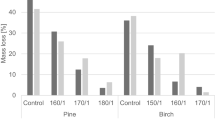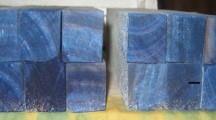Abstract
Synthesis of a new chemical compound combining water-repellence of oleic acid and biocidal effect of boric acid linked by ammonia have been followed and validated by fourier transformed infra red (FTIR). This compound named ammonium borate oleate (ABO) has then been studied as a wood preservative. Different molar ratios of oleic acid have been involved in the synthesis of ABO and leachability of those mixes from wood observed according to Japanese industrial standard. The formulation one mole of boric acid and one of ammonia (1:1:4) for four moles of oleic acid has shown the best efficiency compared to formulations 1:1:1, 1:1:2 and 1:1:3 with about 52% of boron remaining after weathering when other formulations retained respectively 10%, 29% and 46% of boron in the case of an impregnation of Cryptomeria japonica. Seven solutions of 1:1:4 ABO in ethanol of different concentrations were then produced and sapwood blocks of C. japonica and Fagus crenata were impregnated. A toxicity threshold of around 2.0 kg/m3 for both species was determined in a termite resistance test to Coptotermes formosanus indicating the positive effect of combining water repellent and biocide. Termite mortality recording and microscopic observations complete this study indicating that the action mechanism of ABO is providing a water resistant inner coating.
Zusammenfassung
Eine neue chemische Verbindung, welche das Wasserabweisungsvermögen von Ölsaure mit der Schutzwirkung von Borsäure in Verbindung mit Ammonium kombiniert, wurde untersucht und mittels FTIR bewertet. Diese Verbindung namens Ammoniumborat-Oleat (ABO) wurde anschließend bezüglich ihrer Eigenschaft als Holzschutzmittel untersucht. Dabei wurden vier Rezepturen mit verschiedenen Molanteilen Ölsäure bezüglich ihrer Auswaschbarkeit aus dem Holz nach dem Japanischen Industrie-Standard geprüft. Die Rezeptur mit einem Mol Borsäure, einem Mol Ammonium und vier Mol Ölsäure (1:1:4) erwies sich verglichen mit den Rezepturen 1:1:1, 1:1:2 und 1:1:3 als am wirksamsten. Dabei war nach Bewitterung noch etwa 52% Bor vorhanden, wohingegen bei den anderen Rezepturen bei der Imprägnierung von japanischer Zeder (Cryptomeria japonica) nur 10%, 29% und 46% Bor im Holz verblieben. Anschließend wurden mit der Mischung 1:1:4 ABO sieben verschiedene Lösungen unterschiedlicher Konzentration in Ethanol hergestellt. Damit wurden Splintholzproben der japanischen Zeder (Cryptomeria japonica) und der japanischen Buche (Fagus crenata) imprägniert. In einem Termitenresistenzversuch mit Coptotermes formosanus wurde bei beiden Arten ein Toxizitätsgrenzwert von ungefähr 2.0 kg/m3 bestimmt. Dies zeigt die Wirksamkeit der Kombination eines Wasser abweisenden Mittels und eines Biozids. Darüber hinaus wurden Aufzeichnungen der Termitensterblichkeit sowie mikroskopische Untersuchungen durchgeführt, die das Wirkprinzip von ABO durch Bildung einer Wasser abweisenden Schicht im Holz aufzeigen.
Similar content being viewed by others
References
Byrne A, Morris PI (1997) Recent Research in Boron Treatment of Canadian Wood Species. In: The Second International Conference on Wood Protection with Diffusible Preservatives and Pesticides. For Prod Soc:55–61
Drysdale JA (1994) Boron Treatments fot the Preservation of Wood. – A review of Efficacy Data for Fungi and termites. The International Research Group on Wood Preservation. Stockholm, Sweden. Doc IRG/WP 94-30037. IRG secretariat Stockholm, Sweden
Grace JK, Yamamoto RT, Tamashiro M (1992) Resistance of borate-treated Douglas-fir lumber formosan subterranean termites. For Prod J 42(2):61–65
Grace JK, Yamamoto RT (1994) Simulation of remedial borate treatments intended to reduce attack on Douglas-fir lumber by the Formosan subterranean termites (Isoptera: Rhinotermitidae). J Econ Entomol 87(6):1547–1554
Grace JK, Tsunoda K, Byrne A, Morris PI (1994) Field evaluation of borate-treated lumber under conditions of high termite hazard. Abstract. In: Proc. Wood Pres. In the 90s and Beyond. Forest Prod. Soc., Madison, Wis. pp. 240
Highley TL, Green F, Finney WF (1996) Distribution of boron fused borate rods in Douglas-fir transmission poles. The international research group on wood preservation. Doc IRG/WP 96-30112. IRG secretariat Stockholm, Sweden
Hamilton SJ, Buhl KJ (1990) Acute toxicity of boron, molybdenum and selenium to Fry of Chinook salmon and Coho salmon. Arch Environ Contam Toxicol 19:366–373
Jansen JA, Andersen J, Shou JS (1984) Boric acid single dose pharmacokinetics after intravenous administration to man. Arch Toxicol 55:64–67
Japanese Industrial Standard (JIS) K 1571 (2004) Test Methods for determining the effectiveness of wood. preservatives and their performance requirements
Kartal SN, Imamura Y (2004) Effects of N’-N-(1, 8-Naphthalyl) hydroxylamine (NHA-Na) and hydroxynaphthalimide (NHA-H) on boron leachability and biological degradation of wood. Holz Roh- Werkst 62:378–385
Lebow ST, Morell TJ (1989) Penetration of boron in Douglas-fir and western hemlock lumber. For Prod J 39(1):37–70
Lloyd JD (1997) International borate status of borate preservative systems. The second international conference on wood protection with diffusible preservatives and pesticides p. 45–54
Lloyd JD (1998) Borates and their biological applications. The International Research Group on Wood Preservation. Doc IRG/WP 98-30178. IRG secretariat Stockholm, Sweden
Maier KJ, Knight AW (1991) The toxicity of waterborne boron to Daphnia magnia and Chironomus decorus and the effect of water hardness and sulphate on boron toxicity. Arch Environ Contam Toxicol 20:282–287
Mohareb A, Van Acker J, Stevens M (2004) Leachability and efficacy of fatty acid derived boron esters as wood preservatives. The International Research Group on Wood Preservation. Doc IRG/WP 04-30351. IRG secretariat Stockholm, Sweden
Mohareb A, Van Acker J, Stevens M (2002) Effect of protective additives on leachability and efficacy of borate treated wood. The International Research Group on Wood Preservation. Doc IRG/WP 02-30290. IRG secretariat Stockholm, Sweden
Petric M, Pavlic M, Cadez F (2001) Leaching of the New Boron Based Biocide from Coated Wood. The International Research Group on Wood Preservation, Stockholm, Sweden. Doc IRG/WP 01-30267
Peylo A, Willeitner H (1997) Leaching of Boron more than 3 years after exposure. The International Research Group on Wood Preservation, Stockholm, Sweden. Doc IRG/WP 97-30143
Pizzi A (1993a) A new approach to non-toxic, wide-spectrum, ground-contact wood preservatives, Part 1: Approach and reaction mechanisms. Holzforschung 47:253–260
Pizzi A (1993b) A new approach to non-toxic, wide-spectrum, ground-contact wood preservatives, Part 2: Accelerated and field biological tests. Holzforschung 47:343–348
Pizzi A, Baecker AW (1996) A new boron fixation mechanism for non-toxic wood preservatives. Holzforschung 50(6):507–510
Polus-Ratajczak I, Mazela B (2004) The use of blood protein in wood preservatives. Holz Roh- Werkst 62(3):181–183
Preston AF, Mc Kaig PA, Walcheski PJ (1985) Termite resistance of treated wood in an above ground field test. The International Research Group on Wood Preservation. Doc IRG/WP 2241:1-7. IRG secretariat Stockholm, Sweden
Thevenon M-F, Pizzi A, Haluk JP (1997) Non-toxic albumin and soja protein borates as ground-contact wood preservatives. Holz Roh- Werkst 55(5):293–296
Thevenon M-F, Pizzi A, Haluk JP (1998) One-step tannin fixation of non-toxic protein borates wood preservatives. Holz Roh- Werkst 56(1):90
Thevenon M-F, Pizzi A (2003) Polyborate ions influence on the durability of wood treated with non-toxic protein borate preservatives. Holz Roh- Werkst 61(6):457–464
Teshima D, Taniyama D, Oishi R (2001) Usefulness of forced diuresis for acute boric acid poisoning in an adult. J Clin Pharm Ther 2001(26):387–390
Usuda K, Kono K, Orita Y, Dote T, Iguchi K, Nishiura H, Tominaga M, Tagawa T, Goto E, Shirai Y (1998) Serum and urinary boron levels in rats after single adminis-tration of sodium tetraborate. Arch Toxicol 72(8):468–474
Author information
Authors and Affiliations
Corresponding author
Rights and permissions
About this article
Cite this article
Lyon, F., Pizzi, A., Imamura, Y. et al. Leachability and termite resistance of wood treated with a new preservative: ammonium borate oleate . Holz Roh Werkst 65, 359–366 (2007). https://doi.org/10.1007/s00107-007-0192-6
Published:
Issue Date:
DOI: https://doi.org/10.1007/s00107-007-0192-6




